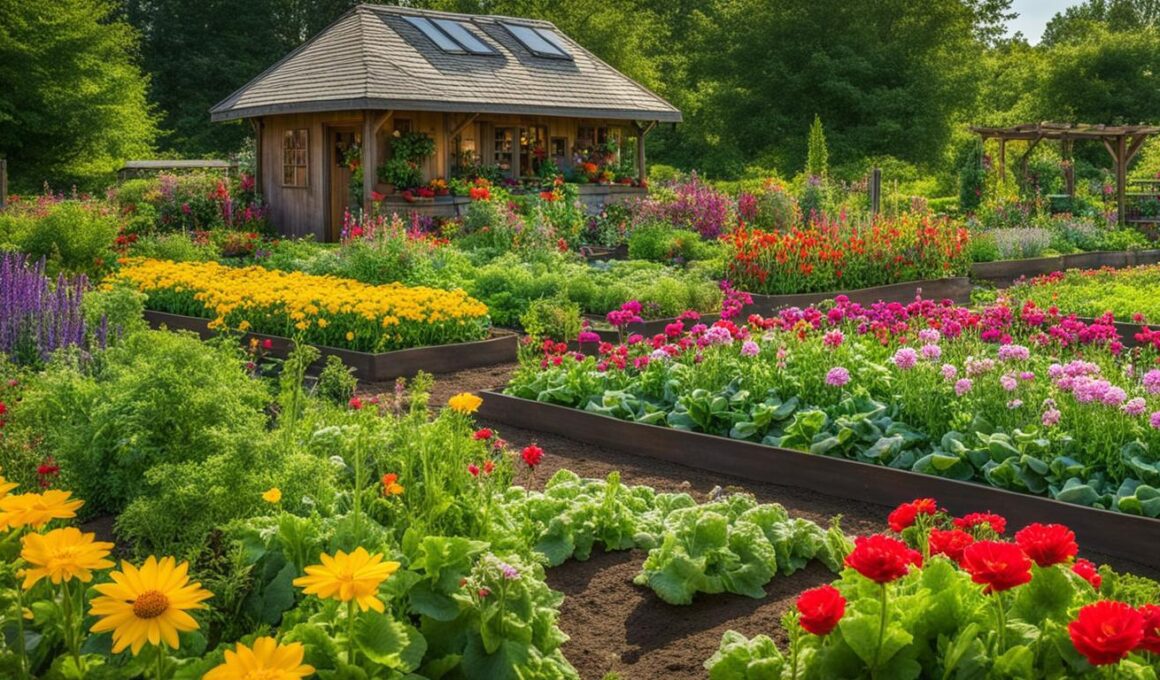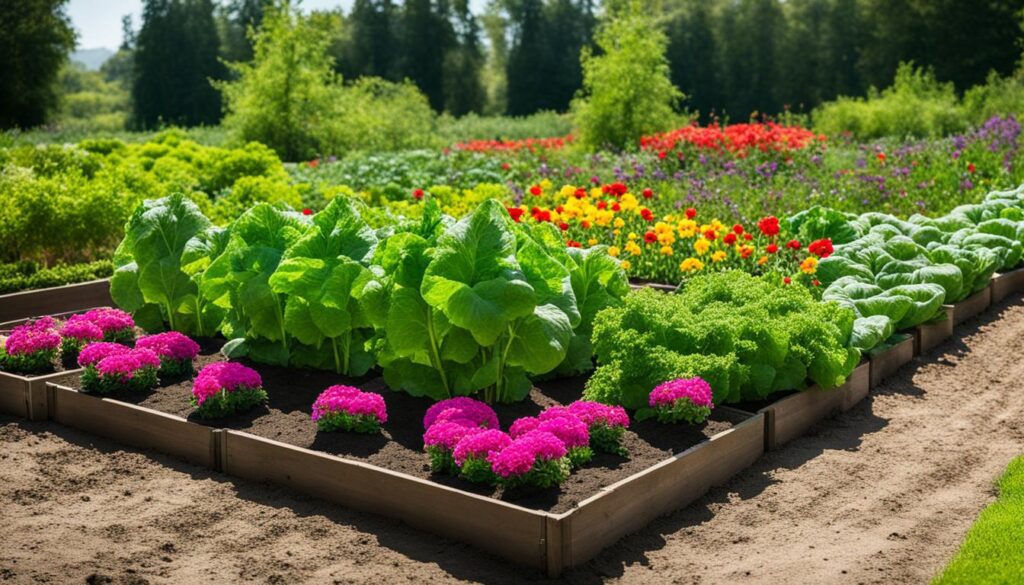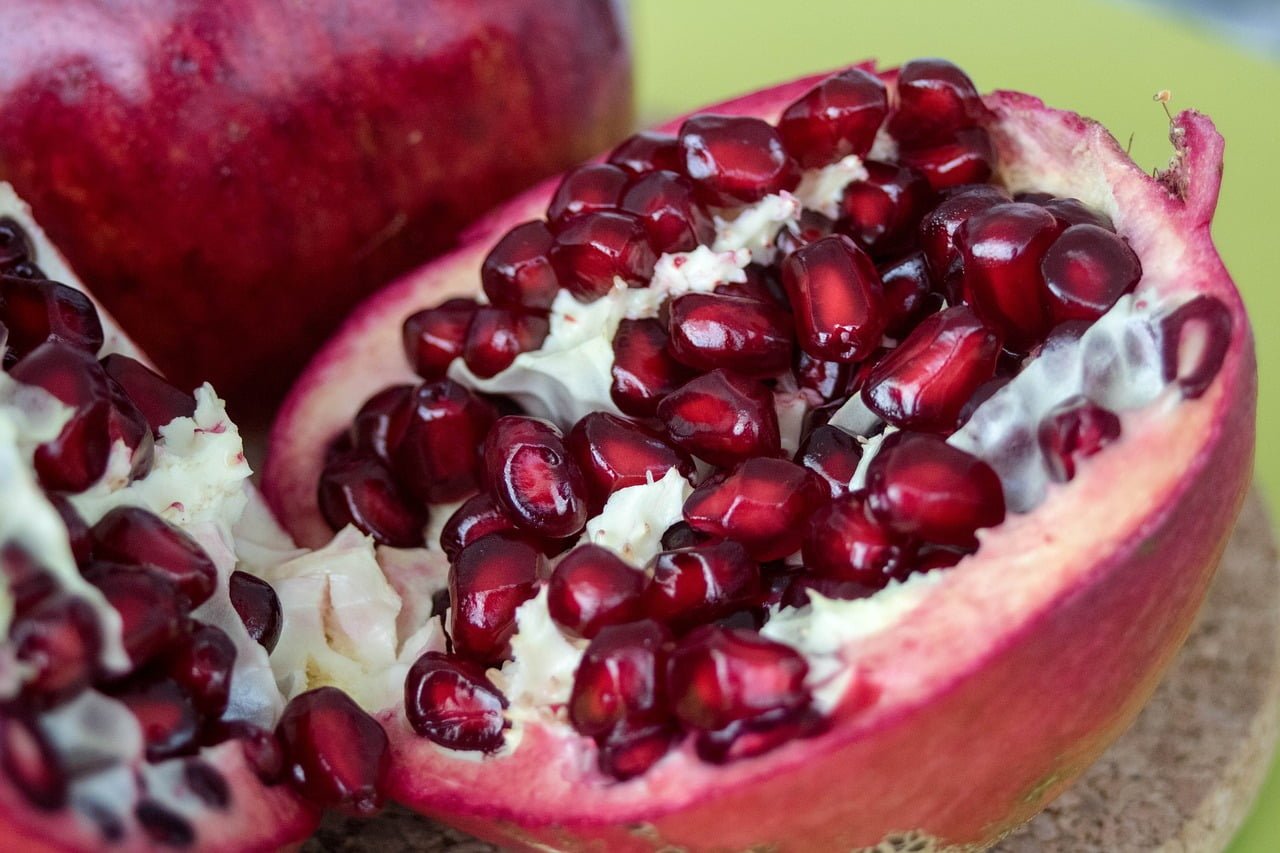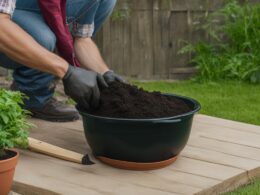Growing a flower vegetable garden is a popular trend among home gardeners. Not only does it provide fresh and healthy produce, but it also adds beauty and biodiversity to your outdoor space. To ensure success, follow these expert tips for starting and maintaining a thriving flower vegetable garden.
Key Takeaways:
- Choose a location with at least six hours of sunlight per day for your flower vegetable garden.
- Incorporate organic matter and compost into the soil to provide essential nutrients.
- Use soaker hoses and drip lines for efficient watering while minimizing evaporation.
- Mulch your garden with organic materials to retain moisture and suppress weeds.
- Encourage beneficial insects and avoid excessive use of insecticides for pest control.
The Importance of Location and Soil for Your Flower Vegetable Garden
When it comes to growing a successful flower vegetable garden, the location and soil play a crucial role in ensuring optimal plant growth and productivity. The right location and soil conditions provide the necessary nutrients, sunlight, and drainage for your plants to thrive.
Firstly, choosing the right location is essential. Most vegetable plants require at least six hours of direct sunlight per day to develop and produce an abundant harvest. Therefore, select a spot in your garden that receives ample sunlight throughout the day. Avoid areas that are shaded by trees or buildings, as this can hinder plant growth and reduce your vegetable yield.
Secondly, the quality of the soil is equally important. Vegetable plants thrive in soil that is rich in organic matter and well-draining. Incorporating compost and other organic materials into the soil helps improve its fertility and water-retaining capacity. It also adds essential nutrients that are vital for healthy plant growth. Prior to planting, ensure that the soil is loose and well-aerated to allow for proper root development and nutrient absorption.
By paying attention to the location and soil of your flower vegetable garden, you are setting a strong foundation for your plants to flourish. Providing them with the right conditions from the start will help ensure a bountiful and successful harvest.
| Location | Soil |
|---|---|
| Choose a sunny spot with at least 6 hours of sunlight per day. | Incorporate compost and organic matter to enrich the soil. |
| Avoid areas shaded by trees or buildings. | Ensure the soil is well-draining and loose. |
| Consider the proximity to a water source for easy irrigation. | Test the pH level of the soil and adjust if necessary. |
Watering and Mulching Tips for Your Flower Vegetable Garden
Proper watering is crucial for the health and productivity of your flower vegetable garden. By understanding the watering needs of your plants and implementing efficient watering techniques, you can ensure optimal growth and yield. Additionally, mulching plays a vital role in preserving soil moisture, suppressing weeds, and protecting plant roots. In this section, we will explore some expert tips for watering and mulching your flower vegetable garden.
Watering Tips
When it comes to watering your flower vegetable garden, it’s important to strike a balance between providing enough moisture to meet the plants’ needs and avoiding overwatering, which can lead to root rot and other diseases. Here are some essential watering tips:
- Water deeply: Ensure that the water penetrates the soil deeply, reaching the plant’s root zone. This encourages the roots to grow deeper and makes the plants more resilient to drought.
- Water in the morning: Watering early in the morning allows the plants to absorb moisture before the heat of the day evaporates it. It also reduces the risk of fungal diseases by ensuring the foliage has time to dry before nightfall.
- Use drip irrigation or soaker hoses: These methods deliver water directly to the root zone, minimizing evaporation and reducing water waste. They also help prevent wetting the foliage, which can lead to diseases.
Mulching Tips
Mulching is a beneficial practice that helps conserve soil moisture, suppress weeds, and improve the overall health of your flower vegetable garden. Here are some tips for effective mulching:
- Choose organic mulch: Use organic materials such as straw, wood chips, or compost as mulch. These materials break down over time, enriching the soil with organic matter and nutrients.
- Apply mulch evenly: Spread a layer of mulch around your plants, ensuring a thickness of 2-4 inches. Be careful not to heap mulch against plant stems, as it can promote rotting.
- Refresh mulch as needed: Mulch can break down over time and lose its effectiveness. Periodically check the mulch layer and replenish it as necessary to maintain its benefits.
By following these watering and mulching tips, you can create an ideal environment for your flower vegetable garden to thrive. Remember to monitor your plants’ water needs and adjust your watering schedule accordingly, especially during hot and dry periods. With proper watering and mulching practices, you’ll enjoy healthy, vibrant plants and bountiful harvests from your garden.
Pest Control and Fertilization Tips for Your Flower Vegetable Garden
When it comes to maintaining a healthy flower vegetable garden, pest control and fertilization are key aspects to consider. By implementing effective strategies, you can protect your plants from harmful insects and provide them with the nutrients they need to thrive. Here are some expert tips to help you with pest control and fertilization in your flower vegetable garden.
Natural Pest Control Methods
- Encourage biodiversity: Create a diverse garden environment by planting a variety of flowers and vegetables. This attracts beneficial insects that prey on pests, helping to naturally control their populations.
- Integrated pest management: Regularly inspect your plants for signs of pests and take immediate action if necessary. Use physical barriers, such as row covers, to protect plants from insects, and manually remove any visible pests.
- Companion planting: Certain plants have natural pest-repellent properties. For example, marigolds can deter aphids and nematodes, while basil can ward off mosquitoes and flies. Integrate these companion plants throughout your garden to help control pests.
Smart Fertilization Techniques
To provide your flower vegetable garden with the nutrients it needs, follow these fertilization tips:
- Test your soil: Before applying fertilizers, conduct a soil test to determine its nutrient levels. This will help you identify any deficiencies and determine the appropriate fertilizers to use.
- Organic compost: Incorporate organic compost into your soil to improve its fertility. Compost adds essential nutrients and improves soil structure, promoting healthy plant growth.
- Slow-release fertilizers: Opt for slow-release fertilizers that provide a steady supply of nutrients over time. This helps prevent nutrient leaching and ensures that your plants receive a consistent amount of nutrition.
- Follow fertilizer instructions: Always follow the instructions provided by the fertilizer manufacturer. Applying too much fertilizer can lead to nutrient imbalances and may damage your plants.
By implementing these pest control and fertilization tips, you can create a thriving flower vegetable garden that is free from pests and nutrient deficiencies. Remember to closely monitor your plants and make adjustments as necessary to ensure their health and productivity.
The Benefits of Companion Planting with Flowers in Your Vegetable Garden
Companion planting flowers with your vegetables offers several benefits. Flowers, such as calendula, California poppy, and sweet alyssum, attract beneficial insects like bees and provide habitat and food sources for them. This helps with pollination and naturally controlling pest populations. By interspersing flowers throughout your vegetable beds, you can create a more biodiverse and efficient garden ecosystem. Choose flowers that bloom at the same time as your vegetables and consider their shape, height, and bloom time to ensure compatibility.
Companion planting can have a positive impact on your vegetable garden in multiple ways. First, flowers act as a natural pest control method by attracting beneficial insects that prey on common garden pests. For example, marigolds release a compound called alpha-terthienyl that repels nematodes, a type of soil-dwelling pest that can damage the roots of your vegetables. Second, flowers can enhance pollination in your vegetable garden. Bees and other pollinators are drawn to the vibrant colors and sweet nectar of the flowers, and as they visit the flowers, they inadvertently transfer pollen to your vegetable plants, increasing fruit set and yield.
Companion Planting Chart
| Vegetable | Companion Flowers |
|---|---|
| Tomatoes | Marigolds, nasturtiums |
| Beans | Marigolds, calendula |
| Cucumbers | Nasturtiums, sunflowers |
| Carrots | Calendula, dill |
When planning your companion planting strategy, consider the specific needs and preferences of the vegetables you are growing. Some vegetables may have specific flowers that they thrive with, while others may benefit from a variety of companion flowers. Additionally, pay attention to the size and growth habit of the flowers to avoid shading or overcrowding your vegetables. By selecting the right companion flowers and arranging them strategically in your vegetable garden, you can create a harmonious and productive growing environment.
Top Flowers to Grow in Your Vegetable Garden for Companion Planting
When it comes to companion planting in your vegetable garden, selecting the right flowers can make all the difference. Not only do they add beauty to your garden, but they also attract beneficial insects that help with pollination and pest control. Here are some top flowers to consider for companion planting in your vegetable garden:
1. Calendula (Calendula officinalis)
Calendula, also known as pot marigold, is a versatile flower that attracts pollinators like bees and butterflies. Its bright yellow and orange flowers are not only visually appealing but also help to trap pests like aphids, protecting your vegetables. Plant calendula near your tomatoes, carrots, and peppers for maximum benefits.
2. California Poppy (Eschscholzia californica)
California poppy is an excellent choice for companion planting in your vegetable garden. Its deep roots break up compacted soil, improving the overall soil structure. The bright yellow and orange flowers attract bees and other beneficial insects, promoting pollination and natural pest control. Plant California poppy near your brassicas, such as cabbage and broccoli, for optimal results.
3. German Chamomile (Matricaria chamomilla)
German chamomile is a delicate flower with white petals and a yellow center. It attracts hoverflies, which are natural predators of aphids, and also adds a touch of beauty to your garden. Plant German chamomile near your cucumbers, onions, and cabbages to enhance their growth and health.
4. Nasturtium (Tropaeolum majus)
Nasturtium is a popular flower for companion planting due to its vibrant colors and edible leaves and flowers. It acts as a natural trap for aphids, diverting them away from your vegetables. Nasturtium also attracts pollinators like bees and butterflies. Plant nasturtium near your squash, tomatoes, and radishes for a vibrant and pest-resistant garden.
By incorporating these flowers into your vegetable garden, you can create a harmonious and thriving ecosystem. The beauty and benefits they bring will not only enhance your gardening experience but also lead to healthier and more abundant harvests. So, get started on companion planting with these top flower choices and enjoy the rewards in your vegetable garden.
What should I plant in my flower vegetable garden after growing brassicas?
After growing brassicas in your garden, it’s important to plan what to plant after brassicas to maintain soil health and prevent crop-specific pests and diseases. Consider planting nitrogen-fixing legumes like peas or beans, followed by root vegetables such as carrots or beets to ensure the overall well-being of your garden.
Conclusion
Growing a flower vegetable garden can be a fulfilling and sustainable endeavor that enhances your outdoor space while providing fresh produce. By following these expert tips, you can ensure the success of your garden and enjoy the beauty and bounty it brings.
First and foremost, consider the location and soil. Choose a sunny spot that receives at least six hours of sunlight daily, and ensure the soil is rich in organic matter and well-draining. Incorporating compost and organic materials will provide essential nutrients and proper water retention for your plants.
Proper watering and mulching are crucial for plant health. Remember to water your vegetable garden adequately, providing about one inch of water per week. Soaker hoses and drip lines are efficient methods that minimize evaporation and wetting of foliage. Mulching with organic materials will help retain moisture, suppress weeds, and protect against diseases.
Pest control and fertilization are important aspects of a thriving garden. Encourage biodiversity by attracting beneficial insects and using natural pest control methods. Avoid excessive use of nitrogen-rich fertilizers and instead incorporate organic compost into the soil to provide necessary nutrients for your plants.
Finally, consider the benefits of companion planting with flowers in your vegetable garden. Interspersing flowers like calendula, California poppy, and sweet alyssum can attract pollinators, control pests, and create a biodiverse garden ecosystem.
So, armed with these expert tips, embark on your journey to grow the perfect flower vegetable garden. With a little care and attention, you can create a beautiful, productive, and sustainable outdoor space.
FAQ
What is a flower vegetable garden?
A flower vegetable garden is a garden that combines both flowers and vegetables in the same space. It adds beauty and biodiversity to your outdoor area while providing fresh and healthy produce.
Where should I locate my flower vegetable garden?
Choose a location that receives at least six hours of sunlight per day. Most vegetable plants thrive in full sun.
What type of soil is best for a flower vegetable garden?
The soil should be rich in organic matter and well-draining. Incorporating compost and organic materials into the soil will provide essential nutrients for your plants and ensure proper water retention.
How often should I water my flower vegetable garden?
Most vegetable plants require about one inch of water per week, including rainfall. Using soaker hoses and drip lines is an efficient way to deliver water directly to the roots while minimizing evaporation and wetting the foliage.
How can I control insects and pests in my flower vegetable garden?
Encouraging biodiversity and attracting beneficial insects can help keep pest populations in check. If necessary, use insecticides responsibly, applying them in the late afternoon or evening when pollinators are less active.
What flowers should I grow in my vegetable garden for companion planting?
Calendula, California poppy, German chamomile, cilantro, nasturtium, and sweet alyssum are great options for companion planting in a vegetable garden. They attract beneficial insects and add beauty to your garden.
How do companion planting flowers benefit my vegetable garden?
Companion planting flowers attract beneficial insects, help with pollination, naturally control pest populations, and create a more biodiverse and efficient garden ecosystem.












